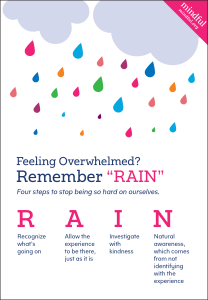Anxiety and stress are normal sensations for human beings. We need a little of these to perform well, but when we become predominantly stressed or anxious even when we don’t need these sensations to perform well, we have a problem. When people experience stress over a prolonged period of time, the body finds it hard to turn the stress response off. Feeling stress/anxiety has become a ‘habitual response to everything’. This is not a healthy way to live, as it depletes our adrenals, loads our circulation- and nervous systems and prematurely ages us.
Mindfulness practice and a good diet are the two key ingredients to decrease unwanted stress and anxiety in your life.
Recent studies have shown that your gut health is an important indication of your total health and well-being, including mental health. I have just listed the key components of a healthy, stress-reducing and ‘good gut promoting’ diet below.
 Avoid stimulants like coffee, tea, alcohol and sugar.
Avoid stimulants like coffee, tea, alcohol and sugar.- Increase your intake of fresh, real foods.
- Increase your intake of probiotics such as sauerkraut or other fermented vegetables, yogurt, kefir, kombucha and kimchi.
- You may like to consider magnesium supplements to support muscle and nerve relaxation.
MINDFULNESS PRACTICES – AWARENESS – MEDITATION
The most important aspect of Mindfulness Based Stress Reduction program is for the mind to focus on a single thing the present moment, the here and now. Anxiety, among other things, is brought on by guilt, shame, reliving a stressful event from the past and or fearing something that is yet to happen. When we have too many things on our mind, yoga often refers to this as the state of Monkey Mind.
The practices listed below, involve our ‘observation awareness’ and through single focused attention we are able to remain in the present moment. These are very effective practices and we start to feel calmer as soon as we practice. Observational awareness creates extra space in the mind, which in turn allow us connect to our inner stillness.This extra space, which in computer terms is comparable to extra working memory and storage space, provides the opportunity for things to shift. Our anxiety and stress may even leave us all by themselves. Any of these following practices have this same space making result, so it is up to you to choose which technique suits you best on any given day.
To find relief from mental chaos we can practice single focus awareness in various ways:
1. BREATH AWARENESS – PRANAYAMA – breathing exercises are central to the mindfulness practice, as the breath is the link between the body and the mind. Our exhalation breath regulates our parasympathetic nervous system, which in turn influences the output of our ‘happy hormones’: serotonin, dopamine, oxytocins and endorphins. When you have anxiety issues, it is important to remember to breath through the nose. To counteract hyperventilating you could practice any of these 5 breathing tips.
– breathing exercises are central to the mindfulness practice, as the breath is the link between the body and the mind. Our exhalation breath regulates our parasympathetic nervous system, which in turn influences the output of our ‘happy hormones’: serotonin, dopamine, oxytocins and endorphins. When you have anxiety issues, it is important to remember to breath through the nose. To counteract hyperventilating you could practice any of these 5 breathing tips.
2. BODY AWARENESS – ASANAS FOR RELAXATION
- Yoga Nidra – is a relaxation practice, which connects the mind to the body. In yoga Nidra the practitioner is guided to connect from the right to the left side of the body while visualizing each part. This practice also offers stability and compassion for the self.
- Restorative yoga is a type of yoga that uses lots of props for support. The poses are held for a long time, up to about 5 minutes, and the transitions are almost in slow motion. The attention is mostly on the breath. Slow movement gives the body time to re-balance itself and slow breathing is a perfect way to calm the mind. Restorative yoga is a large part of my Yoga Bliss Out sessions.
- Progressive muscle relaxation is another way of consciously letting go of stresses in the body. On inhalation you consciously tense each body part and on exhalation you release them again. Starting from the feet: your toes, ankles, back of the legs, buttocks, belly, shoulders, arms, hands, head, face and then the whole body.
3. Mantra repetition – Japa practice. You can use mala beads or any other worry beads and pick a word, which works for you. However, the word you choose needs to be meaningful for you and convey a quality you would like to attain for your own personal development. A lot of ancient words or mantras are said to contain ancient wisdom energy. When we pronounce or proclaim this energy, it is believed that their power will remain with us. Because Sanskrit is such an old language, the words have a high level of meaningful energy, but some Christan words are equally as good for this purpose. Some people have a strong connection to other words and those words can be used as well. Sanskrit examples are: Aum, Nama Shivaya, Shanti or English mantras: Health, Peace, Stillness, Love, Amen, Hallelujah.
4. Visualization – guided visualizations are a wonderful practice to stay in the moment. There are many on the internet you could use.
5. Practicing Art – colouring pictures or doing any type of art work is a great practice for staying in the present moment.
6. Singing or chanting – Singing is also a form of art, but if you can’t sing very well, chanting is a good alternative, as Kirtan (chanting) uses simple melodies, which are repeated over and over. The effects of chanting Kirtan are manifold: It helps with breathing, it releases tension and lets go of energetic blockages. Kirtan also gives you childlike joy of singing simple and uplifting melodies. The repetition of the words has a hypnotic effect on the mind and it allows you to connect to the core of your being. Chanting or Kirtan is similar to mantra repetition, but the music adds an extra element of release and joy.
INSIGHT MEDITATION
Sometimes however, we need some more work to get to where we would like to be. The following practices are more active practices from within the mind. We can alw ays do with a little extra space in the mind, but being able to re-program our internal software could also be very beneficial. This process demands insight into how the mind works (see tendencies of the mind) and then we can become our own inner coach. It is important to stay curious about the mind. We don’t have to be just a passive bystander, who is at the mercy of the mind’s fickleness. Being aware and accepting of your emotions and knowing why they appear and when, is very beneficial for stress reduction. Understanding yourself better leads to you becoming an easier person to live with and balance/peace will prevail.
ays do with a little extra space in the mind, but being able to re-program our internal software could also be very beneficial. This process demands insight into how the mind works (see tendencies of the mind) and then we can become our own inner coach. It is important to stay curious about the mind. We don’t have to be just a passive bystander, who is at the mercy of the mind’s fickleness. Being aware and accepting of your emotions and knowing why they appear and when, is very beneficial for stress reduction. Understanding yourself better leads to you becoming an easier person to live with and balance/peace will prevail.
Insight-meditation practices actively make changes to the way we think. We can break destructive mind patterns of obsessive worrying or remembering with neuro-linguistic programming, positive affirmations and objective reasoning. The key is consistency of practice. Hard-wired patterns and habits take a long time to change.
1. GRATITUDE MEDITATION
This is an antidote to the negatively bias of the mind. Any kind of gratitude injects some positivity back into the mind and restores the balance. Below is just one example:
A. Think of one thing that has happened in your day that made you smile or that filled you with some happiness. This could be the taste of a good coffee, a smile on someone’s face or the sight of beautiful flowers. Then express some gratitude towards this thing or moment. Say: I am grateful for having had this moment in my life. How did this experience feel in your body? Observe.
 B. Now think of a person or animal in your life, which gives you joy and love. Imagine yourself expressing your gratitude for having this person/being in your life. How does this feel in your body?Then imagine this person/being expressing gratitude back to you.How do you feel now?
B. Now think of a person or animal in your life, which gives you joy and love. Imagine yourself expressing your gratitude for having this person/being in your life. How does this feel in your body?Then imagine this person/being expressing gratitude back to you.How do you feel now?
C. Think of a quality or ability you have yourself, for which you are happy to have this quality or ability. Then say to yourself I am grateful for having this quality/ability. Can you feel this gratitude from within your body?
D. Finally combine all these examples and let them flow into one big sensation of gratitude. The feeling is bound to become more than 1 plus 1 plus. Can you feel the presence of gratitude in your body?
2. PRACTICING LETTING GO
Anxiety can also become a habitual state of mind. A few little worries can add up to become quite a burden quite easily, particularly if we hold on to them.
Anecdote: A psychologist walked around a room while teaching stress management
to an audience. As she raised a glass of water, everyone expected they’d be asked the “half empty or half full” question. Instead, with a smile on her face, she inquired: “How heavy is this glass of water?”
Answers called out ranged from 250 grams to 600 grams.
She replied, “The absolute weight doesn’t matter. It depends on how long I hold it. If I hold it for a minute, it’s not a problem. If I hold it for an hour, I’ll have an ache in my arm. If I hold it for a day, my arm will feel numb and paralyzed. In each case, the weight of the glass doesn’t change, but the longer I hold it, the heavier it becomes.” She continued, “The stresses and worries in life are like that glass of water. Thinking about them for a while won’t result in anything. Think about them for a bit longer and they begin to hurt. And if you think about them all day long, you will feel paralyzed – incapable of doing anything.”
It’s important to remember to let go of your stresses. As early in the evening as you can, put all your burdens down. Don’t carry them through the evening and into the night. Remember to put the glass down!
Write a list of the issues, that keep rolling around in your mind.
The RAIN METHOD is an example of re-programming the mind using objective reasoning.It works as follows:
RECOGNIZE – you are carrying a worry, shame, guilt around.
ACKNOWLEDGE – that this worry, shame, guilt exist.
INVESTIGATE – Why you are carrying it. Is it still affecting you and why are you attached to it? Are you able to look at it from another perspective?
NON-IDENTIFICATION, LETTING GO – Are you now able to let it go? Sometimes a little ritual helps our mind to let go of things.
1. You can say it out loud: I now let go of…… and imagine breathing it out.
2. You can write the worry, shame, guilt on a piece of paper, then add: I am done with this for now and forever and chuck it in the bin. Another option is to imagine blowing up a balloon and with each exhalation blow your worry into your balloon. Imagine tying a knot and the let the balloon escape into the ether.
3. Rather than saying to yourself I am hopeless, say: I made a mistake, change I am angry to I feel angry about…, and I am ashamed to I feel shame. This way of wording helps the non-identification process through neuro-linguistic programming.
4. For some people it may be a a good habit to visit your daily worries before you go to sleep and deal with them. In that way, they don’t hang around in the back of your mind the next day or longer. However this process needs to be followed up by a gratitude reflection (see further above)
Sometimes a worry is persistent and keeps coming back. It may be frustrating, but it is quite normal. Recognize its re-occurrence. It may need a few more attempts to deal with it, maybe you need to investigate a bit deeper. Perhaps you need to think about the worst possible outcome of that thing you worry about. How would you deal with that? Most likely, it won’t be as bad as the imagined fear. Remind yourself that the mind likes to catastrophise, and also that you and your mind are not the same thing. Rise above it, pretend your best friend has this worry and then imagine what you would say to your friend to help. Stick with that. Now create a positive affirmation that will help you to release this stress.
Example: ‘I release all stress and move towards peace of mind.’
